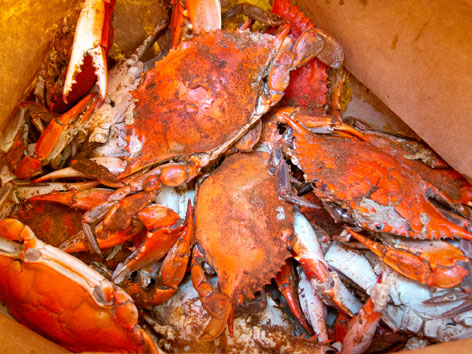<< back to foods in Washington, D.C.

If you’re anything like us, when you get anywhere near Maryland, you’re wondering where you can get some blue crabs! Blue crabs are most associated with Maryland (where it is the state crustacean and largest commercial fishery), but they are native to the whole of the western Atlantic Ocean and Gulf of Mexico—and it just so happens that the brackish waters of the Chesapeake Bay make a particularly ideal habitat. Which means you can find great blue crabs in Washington, D.C., too, during three-quarters of the year.
The live crabs are indeed a dark greenish-blue in color—cooking breaks down that pigment, leaving a reddish-orange hue behind—and they’re distinguished in the crab world for being sexually dimorphic, meaning the two sexes have distinct appearances: Males are identified by a narrow, T-shape abdominal “apron,” or abdomen (it’s said to look like the Washington Monument), whereas females’ are broader, triangular or shaped like the Capitol dome, if it’s a mature female.
As for blue crab season? It extends from April through December, during which time they are harvested, at varying times, as hard-shell crabs, peeler crabs (just before they molt), and soft-shell crabs (just after they molt, in late spring/early summer). We’re fans of the former, finding there’s nothing quite like getting down-and-dirty with a crab mallet and digging out the meat for yourself. It’s a messy affair with a sweet, sweet reward. Here’s where to find blue crabs in D.C.
Good to know: Sadly, blue crab populations have dramatically declined in the Bay over the last decade, due to overexploitation, natural predators, and habitat degradation (warming waters, weather patterns, pollution). New management efforts are constantly undertaken, but some say they’re just not enough. Meanwhile, Louisiana’s commercial blue crab fishery has grown to the largest in the world, and many of its crabs are shipped to Maryland as “Chesapeake blue crabs” (live-crab shipments are common from Florida and Texas, too, whereas crab meat for “Maryland-style crab cakes” often comes here from Southeast Asia or Venezuela). It’s been reported that 98% of crab meat in this region is imported! Always question the source of your crabs, or buy direct from a fish market during the season like we did, which increases your chances of getting the local stuff.
Where: There are restaurants with blue crabs, but we love taking the fresher, cheaper, more DIY route by heading to southwest D.C. and the open-air, no-frills Municipal Fish Market at the Wharf, formerly known as the Maine Avenue Fish Market or just the Fish Wharf, the oldest continuously operating fish market in the country (established in 1805). This is a special place—entirely outdoors on the waterfront, lined with various floating-barge vendors displaying all manner of fish and shellfish, notoriously inexpensive, and downright chaotic on summer weekends (read more about our experience at the Municipal Fish Market here), although you may very likely be the only out-of-towner there: This place is very local, a cultural experience in and of itself.
You can buy your crabs live or cooked, or buy ’em live and wait while they get cooked on the spot for you—then you can eat them there, in a covered seating area, or bring them home. You may have to wait on a few lines, but it’s a worthwhile cause, we promise. Our crabs came from Captain White’s Seafood City (1100 Maine Ave. SW, map), whose website claims its crabs come directly from the Chesapeake Bay. During our visit, signs everywhere likewise advertised “Maryland and Virginia local crabs.”
When: Daily, 8am-8pm
Order: Pictured is our generous paper-bag crab haul for three, which set us back $11. The ordering process can be confounding for newbies. At Captain White’s, as at some of the other stalls here, you can buy live or cooked crabs, so that’s your first decision. The latter are said to have been cooked within the hour; a counter man simply has to season them with Old Bay for you and you’re good to go. We recommend this only if you’re really pressed for time, because taking your just-bought live crabs to the “cook line” for while-you-wait prepping is always gonna yield a fresher crab (the cook line for Captain White’s, mind you, is across the market from the fish stand itself; ask someone to direct you). You will also be asked if you prefer female crabs only (not recommended for sustainability reasons; we got a mix) or medium versus large crabs.
At the cook line, you will take a number and wait your turn. Feel free to browse the market’s options while you wait—there’s chowder, fried fish, and corn on the cob to tempt you, not to mention great people-watching—but don’t miss your number! Then you’ll hand over your paper bag, box, or bushel of crabs to the cook, specify “spicy” if you wish, and wait some more. The crabs are steamed and generously doused with Old Bay; there’s no extra cost for this, but we encourage you to tip your cooks.
You can eat your there at the covered waterfront picnic area reserved for Captain White’s, or take it home like we did (to a rented stoop, no less). The crabs were excellent: sweet meat, spicy seasoning, lots of roe in the females. Your fingernails might smell like crab for a day or two, but it’s all worth it!
Alternatively: There are plenty of good crab houses in Maryland and Virginia—of the all-you-can-eat variety, we’ve heard good things about Arlington’s The Quarterdeck (703-528-2722; 1200 Fort Myer Dr., map) in particular—but options in D.C. proper are pretty limited. You might try Hot N Juicy Crawfish (2651 Connecticut Ave. NW, map), which has blue crabs in season but offers them with seasonings that are more Louisiana than Chesapeake Bay.
There has never been a better time to plan your next trip and make your Dream vacation a reality . Whether you've been dreaming of relaxing on a sun-kissed beach, exploring ancient cities, or embarking on an epic adventure, now is the perfect moment to make it happen.













